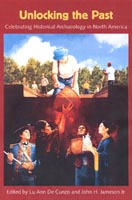The Archaeology of Agricultural Life
Sara Mascia

When we have had the opportunity, archaeologists have studied American farms, plantations, homesteads, tenant homes, and ranches in the last quarter century. We usually know them by the name of one or more of their past occupants, such as the Sherwood Farm, the Spencer-Pierce Little Farm, and the Jethro Coffin site, a practice that reflects the traditional association of the farm with a specific individual or family. Each farm is unique and produced different goods for sale. Archaeologists have excavated at dairy farms, tobacco, corn, wheat and other single crop farms, market gardens, and fruit farms, as well as cattle and sheep ranches.
.The concept of an “agricultural ladder” has been used to describe the levels of advancement toward land ownership. Common farm laborers clung to the bottom of the ladder, tenant farmers perched on the middle rungs, and independent farmers balanced at the top. Landless people struggled to climb until they could buy a farm. Reaching the top of the ladder was one way to achieve the American dream in the nineteenth century. Industrialization, however, was changing the economic foundation of the Americas, as factories and businesses displaced farms. Since World War II, the burgeoning financial and technological world has further reduced our reliance on agriculture as a source of economic security.
We have begun to study farm sites as the sum of all of their parts, in other words, as rural landscapes. We first started studying aspects of the farm complex like farm fences and outbuildings, and how they were used for specific agricultural purposes. This led to studies of farms as functioning entities in the rural environment. Understanding the purpose of a farm as a place of food production is the first step in understanding people’s motivations behind altering the landscape. The National Park Service defines rural historic landscapes as places featuring continuity of “areas of land use, buildings, vegetation, roads and waterways, and natural features.” The definition also emphasizes rural landscapes as “reflect[ing] day-to-day . . . activities of people engaged in traditional work," and that landscapes have "developed and evolved in response to both the forces of nature and the pragmatic need to make a living.” Research by Old Sturbridge Village archaeologists on the changing rural landscape in New England builds on this view of rural sites as "single complex artifacts."
Featured Projects
- Farmstead Archaeology in the Arkansas Ozarks - Leslie C. "Skip" Stewart-Abernathy
- Recounts the author's work with the Arkansas Archaeological Survey and the excavation at the Moser Farmstead Site. The survey discovered rich deposits of late nineteenth- and early-twentieth-century artifacts in a number of farmstead features. Oral history from the people was also used to reconstruct the farmstead plan in detail.
- Archaeology on Western Ranches - Margaret Purser
- The author in this section gives the reader insights on excavating in Western ranches where preservation is dramatic, and a plethora of artifact types and spatial scales can challenge the archaeologist's analytical approaches.
- Feminist Archaeology at a Dakota Village - Sarah McDowell
- In this section, the author reviews archaeologist Janet Spector's pioneering work on the study of the rural lifeways of the Wahpeton Dakota. Spector was able to gain insight on the role of women and girls in this village by examining specific artifacts like awls. With the help of the Dakota community, Spector learned that a young woman who had just officially entered womanhood receives such an awl, and use it to master the work of transforming animal hides into objects of use and beauty.
- Tenant Farmers in Delaware - Lu Ann De Cunzo
- In the later eighteenth and early nineteenth centuryies, capitalism transformed life in the Middle Atlantic region. Archaeology at a tenant farm in Delaware helps tell the stories of this transformation. The author in this section discusses the ways in which agriculture shapes cultures, and helps them connect, through trade, to a world market.
About the Contributors:
Leslie "Skip" Stewart-Abernathy is a Station Archeologist with the Arkansas Archeological Survey and an Associate Professor of Anthropology at the University of Arkansas at Fayetteville.
Margaret Purser is Professor of Anthropology at Sonoma State University.
Sarah McDowell is an anthropology major at the University of Delaware.
Lu Ann De Cunzo is Associate Professor of Anthropology at the University of Delaware.
Return to Archaeology of Work
